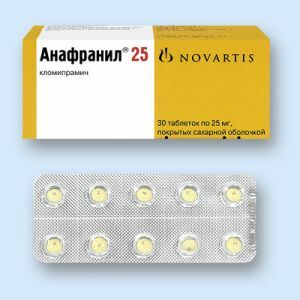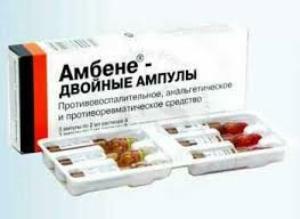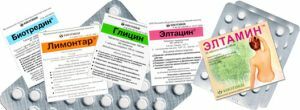 With increasing levels of stress, people are increasingly turning to sedatives. Their use allows not only to ease the condition, but also has a strengthening effect, thanks to additives.
With increasing levels of stress, people are increasingly turning to sedatives. Their use allows not only to ease the condition, but also has a strengthening effect, thanks to additives.
One of these drugs is Glycine, numerous analogues of which can cause difficulties with the selection of medication and confusion in the average person.
The pharmaceutical industry offers a variety of products that have a similar effect, having different characteristics and compositions. The choice is not obvious, let's try to figure it out.
Properties and principle of action of the drug
Glycine is a non-essential amino acid that takes part in the regulation of the nervous system. It increases the effectiveness of 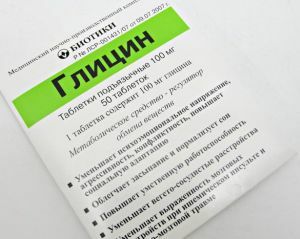 metabolism in the brain and has a sedative effect. As a result, the concentration of attention increases, the level of stress decreases, and work capacity increases.
metabolism in the brain and has a sedative effect. As a result, the concentration of attention increases, the level of stress decreases, and work capacity increases.
The drug has an antioxidant effect, reduces the level of toxins, has an adrenoblocking effect and regulates the work of glutamate receptors. This leads to the normalization of sleep and the activation of mental activity.
Due to its action, Glycine reduces manifestations of vegetative-vascular pathologies, facilitates the restoration of brain activity after injuries and strokes.
The main advantages and disadvantages of the drug
Since the drug has a pronounced effect, it is widely used to restore the work of the nervous system and normalize the psychoemotional sphere.the main indications for use include:
- increased anxiety;
- long-term stress;
- decrease in efficiency of thought processes;
- increased nervous excitability;
- sleep disorders;
- neurotic disorders;
- decreased emotional stability;
- recovery after a previous ischemic stroke;
- alleviation of alcohol or nicotine withdrawal symptoms.
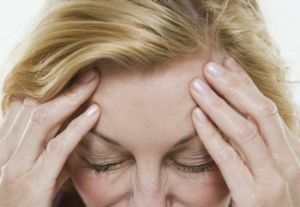 The only contraindication is individual sensitivity to the components of the drug. Side effects during its use are almost not manifested. Most often they are an allergic reaction to the components.
The only contraindication is individual sensitivity to the components of the drug. Side effects during its use are almost not manifested. Most often they are an allergic reaction to the components.
According to reviews on the Glycine preparation placed on the network, many patients note an increase in working capacity and normalization of sleep. Also mentioned is the reduction of headaches and memory improvement.
At the same time, among the negative effects noted by patients can be identified the following:
- attacks of sudden weakness;
- increased drowsiness;
- excitatory action;
- sudden absence of therapeutic effect.
The first three items can be attributed to the peculiarities of the individual reaction of the nervous system. The last point can be explained by excessive uncontrolled reception and developing resistance to the action of the drug.
Variety of forms and types of
When contacting the pharmacy, you can face a wide variety of Glycine species, they all have the same active substance, but differ in dosage and auxiliary components, what exactly is the one to choose from and which of the drugs is better in a particular situation, the attending physician determinesfrom the needs of the patient.
Which of the glycines will help to determine the comparative characteristics of drugs:
- Concentration of active substance in one tablet of Glycine Forte is 300 mg, which is 3 times higher than in usual glycine.
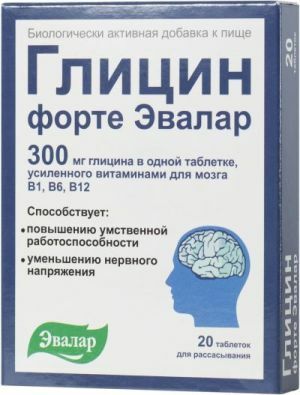 Also included in the composition are vitamins B1, B6 and B12.It is a biologically active additive( BAA), and therefore research on the interaction of other active components with glycine was not carried out.
Also included in the composition are vitamins B1, B6 and B12.It is a biologically active additive( BAA), and therefore research on the interaction of other active components with glycine was not carried out. - Glycine BIO has a composition similar to the original preparation. The dosage of the active substance is absolutely identical. The composition has Povidone, which is an enterosorbent. Clinical trials beyond the standards did not go out.
- The medicine from Canon Forte .The prefix "Forte" usually means a prolonged, more pronounced action. In the preparation, the dosage of the active ingredient is 2.5 times higher than in the original one. Such a composition makes it effective in the complex treatment of disorders of the nervous system. At the same time, a higher dosage implies a wider list of side effects and limitations to admission.
- Glycine- Vis .It is not a medicinal product. The drug itself is encapsulated in a gelatin capsule, allowing active substances to act at the site of absorption. One capsule contains 0.3 g of glycine and 1 mg of vitamins B1 and B6.Also included in the composition is vitamin B12 - it is 3 μg in each capsule. In addition to regulating the work of the central nervous system, affects the work of the heart due to the presence of cyanocobalamin in the composition.
- Glycine MCPA .Nootropic drug, having a dosage similar to the original. The content of excipients is also completely identical, and therefore this drug can be used as an equivalent substitute for the basic.
Choosing analogues - what does the market offer?
Like any other active ingredient, Gotycin has analogues in the group of nootropic drugs. They have other active substances, but the principle of their action is similar.
- Antifront .Oppresses the individual reaction to meteorological changes. It is prescribed for migraines, soreness of joints,
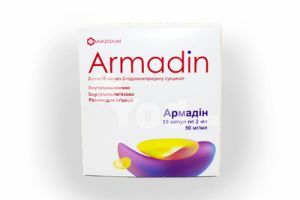 nausea, deterioration of well-being.
nausea, deterioration of well-being. - Armadine .The drug is a broad spectrum of action, used for neurological disorders. It contributes to the relief of the manifestations of the withdrawal syndrome and can be used as a complex therapy for pathologies of the abdominal cavity.
- Glutamic acid .It is prescribed for organic brain damage. Used for congenital malformations( Down syndrome, cerebral palsy) or myopathy.
- Instenon .Used in the treatment of vascular pathologies of the brain and disorders caused by age-related changes. It is used for recovery after a stroke and with functional disorders of the brain.
- Intelland .It is used to treat circulatory disorders of the brain. Promotes recovery in asthenic conditions. Appointed in case of a decrease in the effectiveness of intellectual processes.
- Mexidol .Promotes the restoration of brain activity after the transferred dyscirculatory disorders. Used as an aid for relief of manifestations of withdrawal symptoms.
- Neurotropin .It is prescribed for discirculatory pathologies of the brain. Promotes relief of manifestations of withdrawal symptoms. Reduces the level of anxiety.
- Tryptophan .It is an amino acid. It is used in the treatment of depressive disorders and anxiety. It alleviates the manifestations of premenstrual syndrome, reduces the level of alcohol abstinence.
- Cebrilysin .It is used for neurological and psychiatric pathologies. Used for depressive disorders in the event that there is no reaction to other drugs. Promotes the restoration of brain activity after discirculatory damage.
- Elfoonat .It is used to restore the blood supply to the brain after traumatic or ischemic damage. It is widely used for the treatment of abstinence syndrome and for the purpose of restoring cognitive functions.
Comparison of popular
agents When choosing a nootropic drug, patients can often give in to the recommendations of friends, acquaintances. This leads to a lack of the desired effect and a decrease in the therapeutic effect.
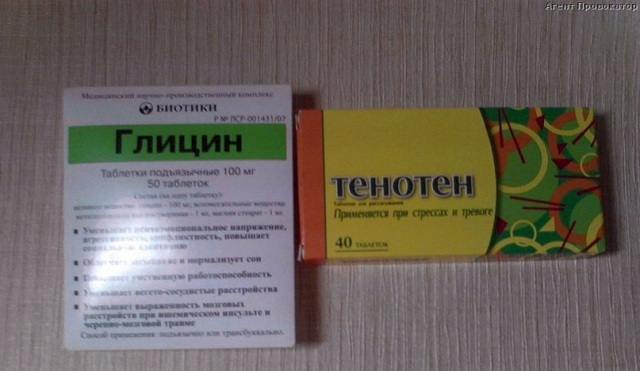
Therefore, before choosing the "absolutely identical" drug, it should be compared with the prescription in order to determine what is better for a particular person to take in a particular situation, as well as among the supposedly complete Glycine analogues, often recommended for substitution and doctors and friends, should be noted the following:
- Tenoten .Has a wide range of applications and shows high efficiency in both traumatic brain injuries and
 in discirculatory disorders. Possible use in neurotic pathologies and conditions. Promotes restoration of emotional background and prevention of aggravation of depressive conditions. In contrast to Glycine, the study of the reception during pregnancy and lactation of Tenoten was not carried out. Therefore, you should refrain from taking in this period.
in discirculatory disorders. Possible use in neurotic pathologies and conditions. Promotes restoration of emotional background and prevention of aggravation of depressive conditions. In contrast to Glycine, the study of the reception during pregnancy and lactation of Tenoten was not carried out. Therefore, you should refrain from taking in this period. - Biotradin .Actively used for the purpose of relief of alcohol withdrawal syndrome. It also helps to restore cognitive processes, increase concentration and improve memory. Glycine, in contrast to Biotredin, has a broader effect and contributes to the restoration of metabolic processes.
- Eltatsin .It is an antioxidant drug. Has a combined effect. The composition includes synthetic analogues of glycine, cystine and glutamic acid. Antioxidant action helps restore the work of the heart muscle. It is used mainly for heart pathologies. In comparison with Glycine has a less broad spectrum of action.
- Afobazole .Sedative drug, used to relieve manifestations of withdrawal. It is used both for alcohol withdrawal syndrome and for the treatment of nicotine addiction. Reduces anxiety. Categorically contraindicated use during pregnancy and lactation, in contrast to Glycine, which can be used in such conditions.
- Glyssede .The most common analog of Glytsin. Has a similar composition. Reduces psychoemotional stress, normalizes sleep, reduces general anxiety. It is also used for functional and organic disorders of cerebral
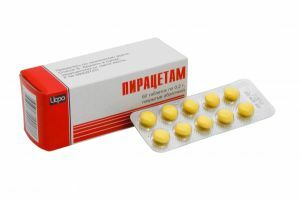 activity.
activity. - Piracetam .A drug for increasing the efficiency of the capillary circulation of the cerebral cortex. This helps to restore the efficiency of mental processes, memory. Requires a systematic reception for a long time. Unlike Glycine, it has no antidepressant effect and is not used to treat psychological disorders.
Interaction with other drugs
When combined with antipsychotics, reduces side effects. It also depresses the occurrence of side effects when combined with antidepressants and hypnotics. Increases the effectiveness of the use of anticonvulsants and drugs of anxiolytics.

